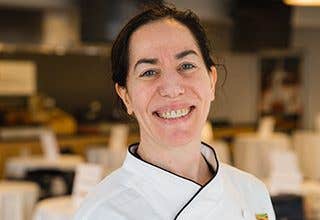A staple grain in the Mediterranean basin, Middle East, and parts of Africa, freekeh is a type of wheat harvested when it’s still young and green. Like all cereals in the wheat family, freekeh contains gluten proteins, making it suitable for a wide range of culinary applications.
Unlike other ancient wheat varieties (e.g., Italian farro or emmer), freekeh traditionally undergoes a post-harvest process that gives it a smoky flavor. This method begins by burning sheaves of freekeh, which imparts a smokiness to the intact moist grains. After the burn, inedible burnt portions are removed by rubbing. The process yields grassy-smoky flavors and a chewy texture similar to farro and cracked bulgur wheat.
Like other starchy cereal grains, freekeh is used in side dishes, salads, and soups. It can be milled into flour for breads and pastries and fermented into probiotic and alcoholic beverages.
Health Benefits
Like most whole grains, freekeh is a good source of protein, B vitamins, magnesium, zinc, and iron. While all whole grains are excellent sources of fiber, freekeh is especially fiber-rich, containing roughly double the fiber of red wheat berries and about four times the fiber found in brown rice. Freekeh is also a good source of prebiotics that nourish beneficial gut microbes.
Where to Buy
Purchase freekeh in Middle Eastern grocery stores or the Middle Eastern or heirloom grain aisles of most large food stores. Alternatively, you can buy freekeh online, either in bulk or in small retail packages.
How to Cook Freekeh
You can purchase freekeh as whole, intact grains, sometimes called whole berries. Whole grains can be cooked on the stovetop using the absorption method described below. Soaking freekeh overnight shortens the cook time by about 10 minutes and softens the bran, which can help with digestibility, but it’s not necessary for a good-tasting final product.
Whole
Combine 1 cup of whole freekeh with 2½ cups water or vegetable broth and a dash of salt. Bring to boiling. Reduce heat. Simmer, covered, for 35 to 40 minutes, until almost all of the liquid has been absorbed. (For soaked freekeh, reduce cooking time to 25 minutes.) Remove from heat. Let sit, covered, 10 minutes more, allowing the grains to absorb any remaining moisture. Fluff grains with a fork. Serve immediately, or store cooked freekeh in an airtight container in the fridge, and incorporate it into your meals throughout the week.
Cracked
You can also find cracked freekeh, which has been broken up into smaller pieces rather than left intact. This lightly processed version of freekeh is easier to digest and quicker to cook, even without overnight soaking. Use the absorption method described above, but reduce the cooking time to 20 to 30 minutes or until all liquid is absorbed.
Seasonings
For added flavor, add whole spices, such as cinnamon sticks, star anise, saffron threads, or a 2-inch length of orange peel, to the cooking water or broth.
Blueberry Bliss Breakfast Bowls with Freekeh
Juicy fresh blueberries meld into chewy-tender freekeh in these easy breakfast bowls, which require just five ingredients and 25 minutes to make.
Freekeh-Grapefruit Tabbouleh
Freekeh works well in recipes that would usually star bulgur, such as tabbouleh. This fresh, healthy twist on the Middle Eastern side salad gets its creaminess from avocado instead of oil. Juicy tart grapefruit rounds it all out.
For more guidance in healthy cooking, check out Forks Meal Planner, FOK’s easy weekly meal-planning tool to keep you on a plant-based path. To learn more about a whole-food, plant-based diet, visit our Plant-Based Primer.

Related News
Get Our Best Price On The Forks Meal Planner

Forks Meal Planner takes the guess work out of making nutritious meals the whole family will enjoy.
Master Plant-Based Cooking!

Our new course features over 100 lessons, 50+ recipes, downloadable guides, and more!



